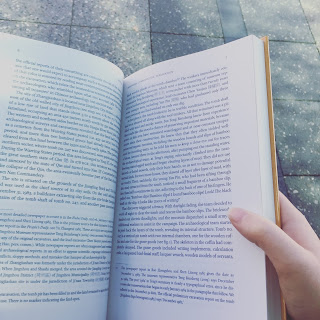Bring some positivity into your studies!
 Lately I’ve been thinking about that off putting feeling when
you don’t want to study, calm or relax enough to enjoy a leisure activity and
you’re feeling far too tired to exercise. It happens and when it does it can
set you back in days of hard study and dedication.
Lately I’ve been thinking about that off putting feeling when
you don’t want to study, calm or relax enough to enjoy a leisure activity and
you’re feeling far too tired to exercise. It happens and when it does it can
set you back in days of hard study and dedication.
It’s unavoidable sometimes. Some strands of psychology
suggest that allowing these meltdown moments to happen actually vital for
avoiding burnout. It may be a sign that you’ve pushed yourself past the
breaking point, and now it is not the time to thrash out that essay which is
due in two months.
Being a studyblr (Study blogger for those of you who aren’t
on my [Instagram] [tumblr] or [twitter] accounts) it can be hard to give
yourself downtime. I love seeing all of you progress, but I’m sure most of you
feel the same pressure. When you see that everyone else is studying, you feel
like you should be. But this isn’t always true.
 Peer pressure is a key factor for why studyblrs are so
successful. We work together as a friendly community that encourages an enthusiasm
and drive for learning and dedication. I’ve never seen a bad word said about
another studyblr, and I’m certainly not knocking the community. However,
addressing the obvious needs of tired workers and students is important. Please
don’t take this post as degrading or down playing the value of the community in
any way.
Peer pressure is a key factor for why studyblrs are so
successful. We work together as a friendly community that encourages an enthusiasm
and drive for learning and dedication. I’ve never seen a bad word said about
another studyblr, and I’m certainly not knocking the community. However,
addressing the obvious needs of tired workers and students is important. Please
don’t take this post as degrading or down playing the value of the community in
any way.
When you’re faced with these ‘icky’ or ‘blank’ feeling
moments, it’s important to immediately recognize the situation. When you’ve had
continuing feelings of demotivation, unhappiness or a serious lack of
motivation, it indicates an emotional imbalance.
As a legal and international relations student, sometimes
the things I study are confronting. This may include severe assault, rape,
potential terrorism or legal defenses for torture. At first, they may appear,
uncomfortable but not disturbing topics. In combination with each other, they
may influence your emotions. This does not mean that you are a weaker person
than other students, but it is important that you bring some positivity back into
your studies.
Bringing positivity to your studies can take three forms:
The first is the most obvious:
The most common method for bringing positivity back into
your studies or work is to use brighter materials. Some bloggers recommended a
scented candle or pen as these are small, unintrusive items that can brighten
your day.
 Simple things like cups of tea can also be advantageous.
It’s a well-known fact that a cup of tea can soothe emotional turmoil.
Interestingly enough it’s because the warmth of the mug simulates being hugged.
That releases a hormonal reaction that encourages a feeling of comfort. Of
course, this warmth can be emulated by any other type of hot drink. I wouldn’t
recommend falling into using coffee as this stimulus does also increase the
level of adrenaline hormones which can encourage anxiety.
Simple things like cups of tea can also be advantageous.
It’s a well-known fact that a cup of tea can soothe emotional turmoil.
Interestingly enough it’s because the warmth of the mug simulates being hugged.
That releases a hormonal reaction that encourages a feeling of comfort. Of
course, this warmth can be emulated by any other type of hot drink. I wouldn’t
recommend falling into using coffee as this stimulus does also increase the
level of adrenaline hormones which can encourage anxiety.
Decorating work spaces, using colored notebooks or stickers
are also simple material ways to bring positivity back into your environment.
You should find that if you pick up on the emotional issue quick enough that
you can move forward with your studies much faster than you would if you
ignored it. With that in mind, mental health is just like physical health.
Sometimes it will recover quickly and other times you may need to rest for a
bit first. Don’t expect yourself to jump straight back into work; you may need
a few days break.
To encourage yourself to relax truly, try taking down any
to-do lists, sticky note reminders, and similar items. You should put them back
up as soon as you feel ready. However, these items may keep you in a continuing
fight or flight feeling. It is very easy to be overcome with the amount of work
you have to do and catastrophize about when it has to be done.
I am famous for messing up due dates and convincing myself
it’s due earlier than it is. Once I submitted a law assignment a full week
early because I’d written it into my diary earlier, in the fear that I would
submit it late. The down side is that I got less time to ask questions, was
more stressed and probably stayed up later working on it than I should have.
The second form of bringing positivity is to bring mental
positivity.
The most common forms of mental positivity are seen in
quotes and meditation.
Quotes work to remind you of your goals and that while
what you’re doing in the short-term is negative; there’s an overall positive
outlook. This is critical for assessing your current mental state. If it ever
appears that you’re unable to move beyond the negativity that you’re currently
facing, you may consider seeking professional help.
Mediation can assist in controlling anxious thoughts and
grounding yourself in the reality of now. Other forms of meditation can also be
witnessed in mindfulness which is a daily habit that can be used for long term
anxiety control. Mindfulness is also great for instilling a more positive
outlook on life and is believed to improve mental concentration.
The third lesser used form of positivity is critical
academic focus:
 A lot of university subjects are
highly biased. This is not necessarily negative, but it can mean you have a
skewed view on an issue. If you find yourself researching a topic that appears
to be nothing but frightening, it may be a good idea to initiate some
independent research Undoubtedly with a little digging you will find an
opposing opinion. While that opinion will not invalidate all the other academic
research, it can help to remind you that what you’re being taught is not always
100% true.
A lot of university subjects are
highly biased. This is not necessarily negative, but it can mean you have a
skewed view on an issue. If you find yourself researching a topic that appears
to be nothing but frightening, it may be a good idea to initiate some
independent research Undoubtedly with a little digging you will find an
opposing opinion. While that opinion will not invalidate all the other academic
research, it can help to remind you that what you’re being taught is not always
100% true.
For example, while poverty is a real issue that is spread
around the globe, there are a lot of papers suggesting that there are real
policy changes that would completely alter the modern existence of poverty.
Focusing on these possible changes and promoting them will provide you with an
alternative positive outlook that could also remotivate you for studying and
hard work.
Good luck remotivating yourself and I hope that even if
you’re not feeling down, you start to bring in a little extra positivity to
your work and studies today!










